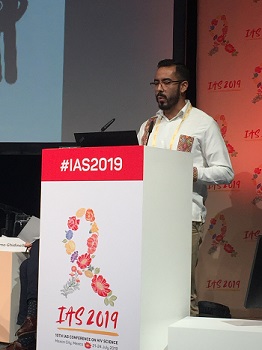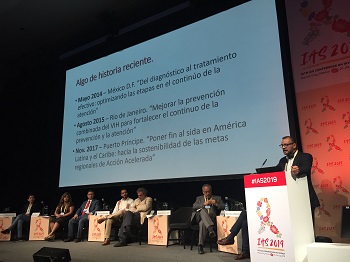Also available in: Español
The symposium about new approaches to monitor HIV services and accelerate the response among men who have sex with men and transgender women in Latin America comes at a time of reflection in the 2019 Conference on HIV Science, which is being held in Mexico.
By: Dennis Castillo
Source: Corresponsales Clave
In Latin America, almost 50% of new HIV infections are found in gay men, other men who have sex with men and transgender women. Therefore, it is necessary to assess the needs and interventions aimed at these groups, which is crucial to achieve the objective of eliminating AIDS by 2030.
In this context, several actors of the region joined efforts to know the prevention state among these populations, advocate for better services, as well as accompany and monitor them.
In this sense, Sergio Montealegre, HIVOS Program Director for Latin American, said that the Global Fund to Fight AIDS, Tuberculosis and Malaria made a unique call to action for the region in 2017, so that regional networks would submit work proposals. Since then, networks started working and looked inwards to know how they were conducting their interventions for prevention, promotion, advocacy and political incidence.
Regarding prevention actions in Latin America, it was discussed in this symposium that most countries are not carrying out prevention campaigns and, where they do, campaigns are not effective and do not reach populations in a direct way. This is alarming considering the political contexts in the region, which put at risk the progress made in the field of human rights, which are closely related to HIV prevention.

Ricardo Baruch, activist, consultant and researcher on health and sexual and reproductive rights issues, questioned what is happening with the epidemics in Mexico. “You might have already heard about it, but the truth is that we are in the middle of a crisis, probably the most relevant crisis regarding HIV in the last 15 years because of different decisions the new government has been taking with respect to prevention and treatment. Things are not going well.”
A case study of Ecuador was presented in this event as well: Corporación Kimirina’s work, which included HIV tests and through which previous screening has been implemented by giving information to people who received guidance before and after the result. The impact of making prevention and timely access to comprehensive health care (in case they were HIV positive) accessible to men had outstanding results: the waiting period between a positive diagnosis and the access to medicines was reduced by more than 50 days.
In the symposium some aspects to be addressed in prevention services for men who have sex with men and transgender women were also discussed, such as taking into account the perception of these populations regarding the services, and getting to know their practices, expectations and knowledge.
It was also mentioned that socioeconomic growth and the inclusion resulting from the actions of civil society organizations of GBT people will eventually lead to a better wellbeing, less poverty, more freedom and less violence in our society. These aspects must be considered to adjust health services to the different populations.
All articles can be shared and published provided the source is cited.


